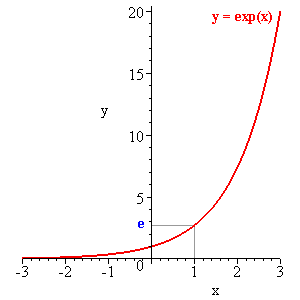|
|
||
The exponential function, denoted by exp x, is defined by two conditions:
Its value for argument 0 is 1.
And it is its own derivative. Comment
Which means its slope is 1 at 0, which means it is growing there, and so it grows faster and, being its own slope, even faster, as x increases. For negative values it never gets to be 0.
If you plot it, and draw a tangent line to it at the argument x, that tangent line will stay below it, and hit the x axis at x - 1.
We can find an expression for exp x as an infinite series of increasing powers of x starting with a constant, by using the defining conditions and the fact that the derivative of an integer power xn is nxn-1
![]()
(If this is not familiar to you take it on faith now; we will prove it later after defining our terms. If you are a beginner at calculus you might find all this mysterious. If so, don't worry, but read the solutions to find out the fundamental properties mentioned below.)
How?
At x = 0, exp is 1, which implies that the first or constant term is 1. This term must be the derivative of another term, and by the power derivative formula above, the only possible term that can have 1 as its derivative is x.
Similarly the only term which will have x as its derivative is ![]() .
And so on, and that leads to the conclusion that the general term in the series
expression for exp x is ...
.
And so on, and that leads to the conclusion that the general term in the series
expression for exp x is ...
Now it is your turn. Finish this sentence by doing the exercises below.

Exercises:
2.1 Figure out the series for exp x and prove it to be so. Solution
2.2 Set up a spreadsheet to compute it up to say the 100th term using your series. Solution
2.3 For x = 1, how many terms do you need to get 10 place accuracy? Solution
2.4 Choose a random x and compute (exp x)*(exp(-x)) with a spreadsheet. What do you get? How about (exp 3x)*(exp(-x))3? Solution
The same kind of series solution can be obtained for any function which is its own derivative or has derivative which is a constant multiple say C of itself.
This fact allows us to prove the fundamental properties of the exponential function.
These are alternate expressions for exp(x + r) and for exp rx.
exp(x + r) has derivative that is itself, but has value exp r when x = 0;
exp rx has value 1 at x = 0, but has derivative that is r multiplied by itself.
Both of these statements are immediate consequences of the chain rule of differentiation which will be discussed ad nauseam in Chapter 7.
Given a positive number a, we can compute an for any integer n by multiplying together n factors of a. We can define a 1/n to be the inverse function to an. And we can define a m/n to be the product of m factors of a 1/n. Thus we can define ar for any rational r.
But how can we define ar for irrational r?
We can prove that for any rational power r that ![]() Take this on faith for the time being.
Take this on faith for the time being.
We will now define xr explicitly so it has this same property.
The condition we need then is that its derivative is itself multiplied by ![]()
This means that ![]() ,
by the chain rule, would have to have derivative
,
by the chain rule, would have to have derivative ![]() multiplied by the derivative of exp x which is exp x. Thus
multiplied by the derivative of exp x which is exp x. Thus ![]() must have derivative that is r times itself.
must have derivative that is r times itself.
But that is exactly what the derivative of exp rx is. And both of these functions are 1 when x is 0.
This means they must have the same power series expansion and therefore must be the same function!
So we have our alternate expression for exp rx and have defined irrational
powers in one swell foop. As for exp(x + r)? It's your turn.
Exercise 2.5 State and prove these fundamental properties, ie, expressions for exp(x + r) and for exp rx. (Hint: what values do they have at x = 0? What are their derivatives? Deduce their series from these statements and identify them.) Solution
Since we have exp rx = (exp x)r, for any x, we can apply it for x = 1, using the fact that we can always write r = 1 * r, to notice: exp r = (exp 1)r .
It is customary to define e = exp 1, so that we can write exp r = er.
The expression ea is used 99% of the time when exp a is meant. In fact, the main use of the notation exp a is when it is inconvenient to use a superscript, as in typing or machine entry, particularly when a has subscripts or superscripts. Computers and spreadsheets use the notation e^a for it, which avoids superscripts but is ugly.
|
|